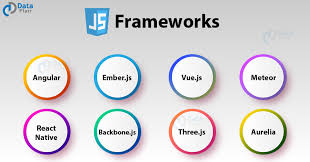Introduction to JavaScript Framework.
In the realm of contemporary web development, JavaScript framework serve as the foundation. Due to a constant need for interactive and adaptable applications, developers are continuously seeking out resources to improve their efficiency and enrich user engagement. As we approach 2025, several prominent contenders reign supreme: React, Angular, Vue, and Svelte. These frameworks each offer distinct capabilities that cater to varying project requirements.
When deciding on a framework, it’s important to consider more than just its popularity or current trends. The most crucial factor is finding one that meets your specific needs. Do you require a framework for building intricate enterprise applications? Or do you need something simpler and flexible? This showdown will thoroughly examine each contender’s advantages and disadvantages, highlighting what sets them apart in a competitive arena. From evaluating performance to analyzing SEO capabilities, we will closely examine these frameworks to determine which one truly excels in the year 2025.
React: The Popular Choice.
React has solidified its position as a top preference for programmers. Its principle of using components enables smooth reusability of code, streamlining the development process and promoting better organization. One of the notable traits of React is its virtual DOM, which improves performance by reducing direct interactions with the real DOM. This leads to quicker rendering and is highly valued by developers for its ability to enhance user experiences.The thriving community centered around React guarantees ongoing progress through strong libraries and tools. Thanks to resources such as Create React App, newcomers can easily get started.
In addition, React is a preferred choice for user interfaces by major companies such as Facebook and Instagram. The fact that it is widely used in these corporations speaks to its strong capabilities and reliability. When it comes to modern web applications, React is often favored for its versatility and superior performance. Its ability to cater to projects of all sizes makes it even more appealing in the current tech industry.
Angular: The All-in-One Solution.
Angular is a standout option for web development, providing a complete solution that encompasses routing, state management, and more. This makes it the preferred choice for building large-scale applications. Created by Google, Angular has strong backing and ongoing updates. Its component-based design enables developers to build reusable elements, greatly increasing development speed. Additionally, the framework promotes the use of TypeScript, leading to improved maintainability and readability of code. This aspect is particularly advantageous in a team setting where teamwork is crucial.
Additionally, the robust CLI of this tool simplifies project setup and scaffolding, enabling new users to swiftly initiate their work. Angular is equipped with built-in tools for testing and performance optimization, providing smooth execution of applications on different platforms. This makes it a popular choice for enterprise-level projects that prioritize reliability and scalability.
Vue: The Lightweight Option.
Vue has established itself as the preferred choice for those seeking a lightweight JavaScript framework. Its user-friendly approach and seamless integration capabilities make it a desirable option for developers across all proficiency levels. An impressive aspect of Vue is its manageable learning curve. Beginners can easily understand the fundamentals, enabling them to create applications without being daunted. This quality makes Vue a great option for both minor projects and bigger applications.

Vue stands out in terms of performance, as its virtual DOM implementation operates with maximum efficiency. By only updating essential elements, it guarantees seamless interactions, even when faced with constantly changing environments. It is worth mentioning the versatility of Vue, as it can serve as a complete framework or smoothly integrate into preexisting projects. The team’s adaptability allows them to prioritize providing excellent user experiences and maintaining orderly and manageable code. The community also offers valuable resources that will continue to enhance Vue’s appeal in the years to come.
Svelte: The Newcomer on the Block.
Svelte has rapidly captured the interest of developers due to its unique approach. Unlike traditional frameworks, it prioritizes compile time over virtual DOM usage, resulting in exceptionally fast Svelte applications. The syntax is both clean and intuitive, promoting swift development without excessive boilerplate code. Its simplicity is favored by developers, despite still offering robust capabilities. A notable feature of Svelte is its smooth handling of state management within components. This streamlines the process and removes the potential complications commonly seen in competing frameworks, making it an appealing choice for starting fresh on a project.
As Svelte gains more community backing and comprehensive documentation, individuals are questioning if it will serve as a formidable competitor against established frameworks such as React and Angular in 2025. Its unique methodology has the potential to revolutionize our expectations for frontend frameworks in the future.
Angular: The All-in-One Solution.
Angular is a standout choice for web development due to its all-in-one package which covers everything from routing to state management. It’s the go-to solution for large-scale applications. Angular, created by Google, benefits from strong support and regular updates. With its modular design, developers can easily create reusable components, resulting in a notably faster development process. The framework also highlights the use of TypeScript, which improves code maintainability and readability.
This is especially advantageous in team settings where collaboration is crucial.In addition, the robust CLI (Command Line Interface) simplifies project setup and scaffolding, facilitating an efficient start for beginners.Angular’s built-in testing and performance optimization tools guarantee a smooth running application on multiple platforms, making it the perfect choice for enterprise-level projects that require reliability and scalability.
Choosing the Right JavaScript Framework for Your Project.
Selecting the appropriate framework is dependent on the unique requirements of your project. Begin by evaluating the scope and intricacy of your development goals. Will you be creating a basic application or a more intricate enterprise solution? Furthermore, keep in mind the knowledge and capabilities of your team. Implementing a different framework may impede workflow if developers are unaccustomed to it. However, utilizing the React proficiency of your team can expedite development.
In addition, it is important to consider performance. While certain frameworks may excel in speed, others may prioritize features and tools aimed at improving productivity. Therefore, it is crucial to keep loading times and user experience in mind while making your decision. It is important to take advantage of the community support and resources offered by each framework. Strong communities provide access to various plugins, libraries, and documentation, which are valuable tools for addressing any development issues that may arise.
Pros and Cons of Each JavaScript Framework.
React stands out with its component-based structure and expansive community. It proves to be an excellent tool for creating user interfaces, but it can become daunting with the constant stream of updates. This can present a challenge for developers trying to keep up. Angular is equipped with robust tools, making it a comprehensive choice for large applications. Although, its challenging learning curve may discourage new users. Vue stands out for its user-friendly framework that prioritizes flexibility and simplicity. However, unlike React or Angular, which have larger communities, some may criticize Vue for its lighter weight.
Svelte offers innovative concepts by compiling code during the build stage rather than in the browser. While this results in improved performance, it also means that there are fewer resources and community support compared to established frameworks. Each choice presents distinct advantages and disadvantages suited to varying project requirements and developer inclinations.
Conclusion.
When it comes to your project’s success, the choice of JavaScript framework is crucial. Looking towards 2025, it is evident that React, Angular, Vue, and Svelte each have their own distinct advantages to offer. React remains a dominant force in the industry, thanks to its adaptability and extensive range of tools. It remains a favored choice for developers looking for impressive performance. Angular provides a comprehensive package for those seeking an all-encompassing solution, although it may require more effort to master. For beginners or those working on smaller projects, Vue stands out as a lightweight yet functional option that prioritizes user-friendliness. And finally, Svelte is gaining popularity due to its unique compile-time approach that promises speedier applications.Additional contenders should also be taken into account, depending on the specific needs and goals of the project. In the evaluation of “React vs Angular vs Vue in 2025,” it is imperative to consider performance metrics and their impact on SEO strategies. By evaluating the advantages and disadvantages of various frameworks, you can make a well-informed decision that fits your specific needs while also considering future developments. Whether your priorities are speed, size, or SEO capabilities now and in the future, the ideal framework should seamlessly align with your development goals and meet user expectations.






